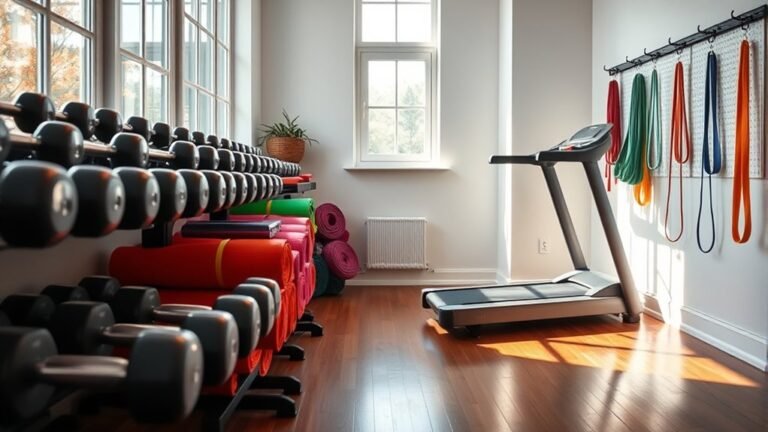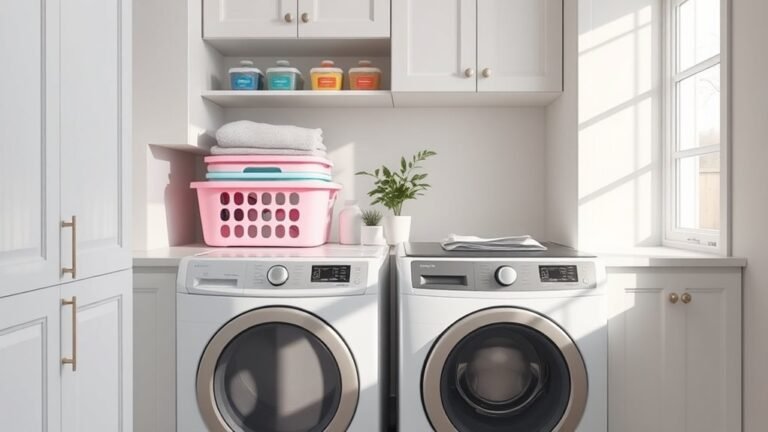Step-By-Step Guide to Cleaning Couch
First, identify your couch’s material by checking care labels to choose the right cleaning method. Gather supplies like a vacuum, soft brushes, and fabric-safe cleaners. Remove cushions and vacuum thoroughly to prep for cleaning. Treat stains promptly using appropriate solutions—water-based or oil-based—and always test on hidden spots. Follow deep cleaning tips specific to fabrics like leather or microfiber for best results. Want to keep your couch looking fresh and maintain its texture? There’s more helpful advice ahead.
Assessing Your Couch Material

How do you know the best way to clean your couch? Start by evaluating your couch material carefully. Every fabric type demands a unique approach, so understanding what you’re working with is essential. Check the care labels sewn into your couch—they’re your freedom guide, telling you what cleaning methods are safe or risky. Whether your couch is leather, microfiber, cotton, or a synthetic blend, the label will often indicate whether you can use water, solvents, or need professional help. Ignoring this step might lock you into damage or stubborn stains. So, take a moment, identify the fabric type, and respect the care instructions. This knowledge lets you clean confidently, preserving both your couch and your independence from costly repairs.
Gathering Cleaning Supplies
Before you start cleaning, make sure you have the right tools on hand, like a vacuum, soft brushes, and microfiber cloths. You’ll also want to choose cleaning products that match your couch’s material to avoid damage. Having everything ready will make the process smoother and more effective.
Essential Cleaning Tools
To effectively clean your couch, you’ll need a few essential tools that make the job easier and more thorough. Having the right cleaning tools is key to couch maintenance, letting you restore freshness without hassle. Here are three must-haves to gather before you start:
- Vacuum Cleaner with Attachments – Perfect for removing dust, crumbs, and pet hair from every nook and cranny.
- Soft-Bristled Brush – Helps loosen dirt embedded in fabric fibers without damaging your couch.
- Microfiber Cloths – Ideal for gentle wiping and drying, absorbing moisture without leaving streaks.
With these tools ready, you’re set to take control of your couch’s cleanliness, ensuring it stays inviting and comfortable while giving you the freedom to tackle any mess confidently.
Suitable Cleaning Products
Although choosing the right cleaning products might seem straightforward, picking ones that suit your couch’s material is essential for effective and safe cleaning. You don’t want to risk damage or lingering odors, so start by checking the manufacturer’s label for recommended cleaners. Opt for eco friendly cleaners whenever possible—they’re gentle on both your couch and the environment. Fabric safe detergents are a must, especially if your couch is upholstered with delicate materials like linen or velvet. Avoid harsh chemicals, bleach, or anything abrasive that could strip color or weaken fibers. By selecting the right products, you maintain your couch’s look and feel without compromising your freedom to enjoy a fresh, clean space. Keep these choices in mind as you gather your supplies for the next steps.
Preparing the Couch for Cleaning

Before you start cleaning, take off all cushions and pillows to access every spot. Give the entire couch a thorough vacuum to remove dust and debris. Don’t forget to check the manufacturer’s cleaning instructions to avoid damaging the fabric.
Remove Cushions and Pillows
Start by removing all cushions and pillows from your couch; this simple step makes the cleaning process much easier and more effective. Taking cushions and pillows off gives you full access to every nook and cranny, ensuring thorough cushion care and pillow protection. Here’s how to do it right:
- Gently lift each cushion to avoid damaging the fabric or frame.
- Place pillows in a safe, dry area to maintain their shape and freshness.
- Inspect cushions for removable covers to wash separately, enhancing cleanliness and longevity.
Vacuum Surface Thoroughly
Once you’ve removed the cushions and pillows, it’s time to vacuum the entire surface thoroughly. This step is essential for effective upholstery care, as it frees your couch from dust, crumbs, and pet hair. Using the right vacuuming techniques guarantees you don’t damage the fabric while achieving a deep clean.
| Vacuuming Techniques | Upholstery Care Tips |
|---|---|
| Use a brush attachment | Test suction on a hidden spot |
| Move in slow, overlapping strokes | Focus on seams and crevices |
| Avoid harsh scrubbing | Vacuum regularly for maintenance |
Check Cleaning Instructions
How do you know which cleaning method is safe for your couch? Before diving into any cleaning, checking the manufacturer’s label is your best move. It guides you through the right cleaning methods and guarantees you don’t damage your fabric. Here’s how to get started:
- Locate the fabric care tag, often under cushions or on the frame.
- Read the symbols or instructions—it’ll tell you if water-based or solvent-based cleaners are best.
- Follow these directions strictly to protect the fabric and keep your couch looking fresh.
Removing Stains and Spots

Although stains and spots can be frustrating, addressing them quickly will prevent permanent damage to your couch. First, identify the stain types—whether it’s oil-based, water-based, or something else—as each requires a different spot treatment. For water-based stains like soda, blot the area gently with a damp cloth, avoiding rubbing. Oil-based stains, such as grease, often need a bit of dish soap mixed with water to break down the residue. Always test your chosen spot treatment on a hidden area to avoid discoloration. Acting fast and using the right method gives you the freedom to keep your couch looking fresh without hassle. Remember, prompt and proper care is your best defense against stubborn stains and spots.
Deep Cleaning Techniques for Different Fabrics
Because every fabric reacts differently to cleaning methods, it’s important you choose the right deep cleaning technique for your couch material. Proper fabric care guarantees your couch stays fresh while preserving its texture and color. Here are three effective cleaning methods tailored to common fabrics:
- Microfiber: Use a gentle upholstery cleaner with a soft brush to lift dirt without damaging fibers.
- Leather: Apply a leather-specific cleaner and conditioner to deep clean and maintain suppleness.
- Cotton or Linen: Opt for a water-based cleaner or mild soap solution, then gently blot to avoid fabric distortion.
Drying and Maintaining Your Couch
Once you’ve thoroughly cleaned your couch using the right method for its fabric, the next step is to guarantee it dries properly and stays in good condition. Start by airing it out in a well-ventilated room or use fans to speed up drying, avoiding direct sunlight that can fade the fabric. To keep your couch looking fresh and lasting longer, invest in fabric protection—like sprays that repel stains and spills. Make regular upkeep part of your routine: vacuum weekly to remove dust and debris, and spot-clean spills immediately. This simple care frees you from constant deep cleaning, letting you enjoy your couch without worry. With proper drying and consistent maintenance, your couch will remain a comfortable, stylish centerpiece in your space.
Frequently Asked Questions
How Often Should I Professionally Clean My Couch?
You should consider your cleaning frequency based on how much you use your couch and your lifestyle. For ideal couch maintenance, getting it professionally cleaned every 12 to 18 months keeps it fresh and prolongs its life. If you have pets or kids, you might want to do it more often. Keeping up with regular professional cleanings gives you the freedom to relax without worrying about dirt or allergens building up.
Can Pets Cause Long-Term Damage to Couch Fabric?
Yes, pets can definitely cause long-term damage to your couch fabric. Pet stains, like urine or saliva, can seep into the fibers and create persistent odors or discoloration. Plus, your furry friend’s claws and constant rubbing can accelerate fabric wear, making your couch look worn out faster than you’d like. To keep your freedom to relax without worry, it’s smart to clean stains promptly and use protective covers or treatments.
Are There Eco-Friendly Couch Cleaning Products?
You’ll be glad to know there are plenty of eco-friendly couch cleaning products available that use natural cleaners, perfect for upholstery care without harsh chemicals. These options let you keep your space fresh and safe while respecting the environment. You don’t have to sacrifice effectiveness for sustainability—you can choose natural, plant-based solutions that clean deeply and protect your freedom to live green and clean, all while caring for your furniture gently.
What Are the Best Ways to Prevent Couch Odors?
You know what they say: prevention is better than cure. When it comes to couch odors, regular couch maintenance tips are your best friend. Vacuum frequently to remove dust and crumbs, and use odor removal techniques like sprinkling baking soda, letting it sit, then vacuuming it up. Keep your couch dry and air it out often. These simple habits help you enjoy a fresh, inviting space without feeling trapped by lingering smells.
How Do I Clean Couch Cushions With Zippers?
When cleaning couch cushions with zippers, you’ll want to focus on both cushion care and zipper maintenance. First, unzip and remove the covers carefully to avoid snagging. Wash the covers according to the label instructions to keep them fresh. For zipper maintenance, gently clean the zipper teeth and apply a little lubricant if it sticks. This way, you’ll keep your cushions looking great and zippers working smoothly, giving you freedom from hassle.






